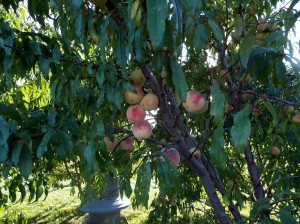How to Improve Soil Nutrients
Salt the Earth
I spent the last couple of days getting the garden ready. The asparagus bed, pumpkin patch, vegetable garden and orchard trees have been salted to Improve Soil Nutrients.
I read about how to improve soil nutrients and the benefits of sea salt for boosting trace elements in an article from Acres USA, January 2003. This winter I re-read the book Sea Energy Agriculture by Maynard Murray, M.D.
Dr. Murray presents evidence of the declining trace elements of soil. When commercial fertilizers are applied only the basic elements are returned to the soil. The abundance of these; nitrogen, phosphorus, potassium and lime initially increase crop yield, however, they block uptake of necessary elements.
The science behind Sea Energy Agriculture is that the chemistry of sea life is naturally disease resistant and nutritionally superior. Sea salts added to soils are properly balanced between trace elements and sodium chloride. The application rate is important, too. The application is reasonable to restore the soil’s missing elements without rendering it useless like Carthage after the Romans salted the earth.
The best defense against disease is good nutrition. That nutrition starts in the soil. Plants take up the minerals which are then distributed to the end consumer whether human, livestock or wildlife. These end crops are nutrient dense and superior in trace elements.
In the past I’ve tried getting the geese to weed the asparagus beds. Instead of pulling out the grass they pulled up all the strawberry plants in the next bed over. This year I’m experimenting by using a high rate of Redmond Salt to kill the grass in the asparagus bed. The heavier application won’t hurt the crop, instead it will restore elemental nutrients while inhibiting the invasive grasses.
Both SEA-90 and Redmond Salt are certified organic (OMRI listed). The difference is where the sea mineral solids are sourced. SEA-90 is from an estuary where sea water is captured and dried. Redmond salt is sourced from deposits in Redmond Utah.
As an experiment both products are being applied separately to the orchard trees and garden. Here on the farm there are two areas with heirloom apple trees, two areas with peach trees and one group of cherry trees of three different varieties. I don’t know whether the difference between the two products will be significant, we’ll find out at the end of the growing season.
Redmond salt is sold by a local supplier, which is convenient. There aren’t any SEA-90 suppliers in our area so I bought enough for half of our vegetable garden and half of the orchard trees through Amazon.
Last fall the pastures were salted with Redmond salt, 50 pounds per acre, to improve the balance of the soil. This spring we’ll repeat the salt application. We’ve seen great promise in pasture growth using sea solids and the livestock prefer grazing the fields where it’s been applied.

